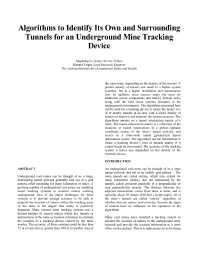Mining Publication: Algorithms to Identify Its Own and Surrounding Tunnels for an Underground Tracking Device
Original creation date: January 2010
Underground coal mines can be thought of as a large, intersecting tunnel network generally laid out in a grid pattern, often extending for many kilometers or miles. A growing number of underground coal mines are installing miner tracking systems to monitor miners working underground. One of the major challenges for these systems is to provide enough accuracy to be able to pinpoint the location of miners within the working areas of the mine to the degree that safety is positively impacted. Many current mine tracking systems use a limited number of sensors placed within key tunnels or intersections of the mine as location references to estimate the location of a tracking device carried by the mine worker. The accuracy of those systems could be less than 15 m in one area or greater then 300 m in another area of the same mine, depending on the density of the sensors. A greater density of sensors can result in a higher system accuracy, but at a higher installation and maintenance cost. In addition, more sensors imply the need for additional power components and battery backup units, along with the risks those systems introduce in the underground environment. The algorithms presented here can be used for a tracking device to locate the tunnel it is in or nearby tunnels in an area with a lesser density of sensors to improve and maintain the system accuracy. The algorithms operate on a tunnel intersection matrix of a mine. The tunnel intersection matrix is a collection of the locations of tunnel intersections in a global coplanar coordinate system of the mine’s tunnel network, and serves as a mine-wide tunnel geometrical layout information source. The algorithms use the information to locate a tracking device’s own or tunnels nearby if it cannot locate its own tunnel. The accuracy of the tracking system is hence less dependent on the density of the external sensors.
Authors: J Li, RL Unger
Conference Paper - January 2010
NIOSHTIC2 Number: 20036705
Proceedings of the ION International Technical Meeting (ITM) 2010, January 25-27, 2010, San Diego, California. Fairfax, VA: The Institute of Navigation, 2010; :190-197
See Also
- Advanced Tutorial on Wireless Communication and Electronic Tracking: Mine Operations Center (MOC)
- Exploration of Two Position Adjustment Methods for Underground Mine Tracking Systems
- Mine Communications and Tracking Glossary
- Mining Communications and Tracking
- Passive Fiber Optic System for Locating, Tracking, and Communicating with Personnel in Coal Mines
- Straight Line Walking and Path-Turn Identifying Algorithms for a Tracking Device Used in Underground Mines
- Technology News 544 - New Measurement Tool to Validate Wireless Communications and Tracking Radio Signal Coverage in Mines
- Through-The-Earth Wireless Real-Time Two-Way Voice Communications
- Waveform Generator-Package and Receiver: Mancarried and Helicopter Receiver Portion
- Wireless Mesh Mine Communication System
- Page last reviewed: 9/21/2012
- Page last updated: 9/21/2012
- Content source: National Institute for Occupational Safety and Health, Mining Program


 ShareCompartir
ShareCompartir
